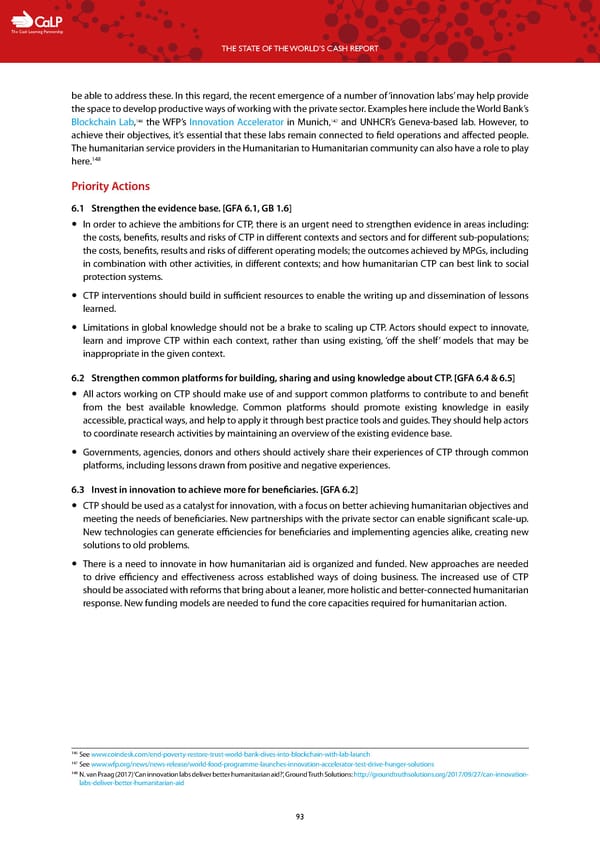C The Cash Learning Partnership THE STATE OF THE WORLD’S CASH REPORT be able to address these. In this regard, the recent emergence of a number of ‘innovation labs’ may help provide the space to develop productive ways of working with the private sector. Examples here include the World Bank’s 146 147 Blockchain Lab, the WFP’s Innovation Accelerator in Munich, and UNHCR’s Geneva-based lab. However, to achieve their objectives, it’s essential that these labs remain connected to field operations and affected people. The humanitarian service providers in the Humanitarian to Humanitarian community can also have a role to play 148 here. Priority Actions 6.1 Strengthen the evidence base. [GFA 6.1, GB 1.6] — In order to achieve the ambitions for CTP, there is an urgent need to strengthen evidence in areas including: the costs, benefits, results and risks of CTP in different contexts and sectors and for different sub-populations; the costs, benefits, results and risks of different operating models; the outcomes achieved by MPGs, including in combination with other activities, in different contexts; and how humanitarian CTP can best link to social protection systems. — CTP interventions should build in sufficient resources to enable the writing up and dissemination of lessons learned. — Limitations in global knowledge should not be a brake to scaling up CTP. Actors should expect to innovate, learn and improve CTP within each context, rather than using existing, ‘off the shelf’ models that may be inappropriate in the given context. 6.2 S trengthen common platforms for building, sharing and using knowledge about CTP. [GFA 6.4 & 6.5] — All actors working on CTP should make use of and support common platforms to contribute to and benefit from the best available knowledge. Common platforms should promote existing knowledge in easily accessible, practical ways, and help to apply it through best practice tools and guides. They should help actors to coordinate research activities by maintaining an overview of the existing evidence base. — Governments, agencies, donors and others should actively share their experiences of CTP through common platforms, including lessons drawn from positive and negative experiences. 6.3 Invest in innovation to achieve more for beneficiaries. [GFA 6.2] — CTP should be used as a catalyst for innovation, with a focus on better achieving humanitarian objectives and meeting the needs of beneficiaries. New partnerships with the private sector can enable significant scale-up. New technologies can generate efficiencies for beneficiaries and implementing agencies alike, creating new solutions to old problems. — There is a need to innovate in how humanitarian aid is organized and funded. New approaches are needed to drive efficiency and effectiveness across established ways of doing business. The increased use of CTP should be associated with reforms that bring about a leaner, more holistic and better-connected humanitarian response. New funding models are needed to fund the core capacities required for humanitarian action. 146 See www.coindesk.com/end-poverty-restore-trust-world-bank-dives-into-blockchain-with-lab-launch 147 See www.wfp.org/news/news-release/world-food-programme-launches-innovation-accelerator-test-drive-hunger-solutions 148 N. van Praag (2017) ‘Can innovation labs deliver better humanitarian aid?’, Ground Truth Solutions: http://groundtruthsolutions.org/2017/09/27/can-innovation- labs-deliver-better-humanitarian-aid 93
 The State of the World's Cash | Full Report Page 94 Page 96
The State of the World's Cash | Full Report Page 94 Page 96